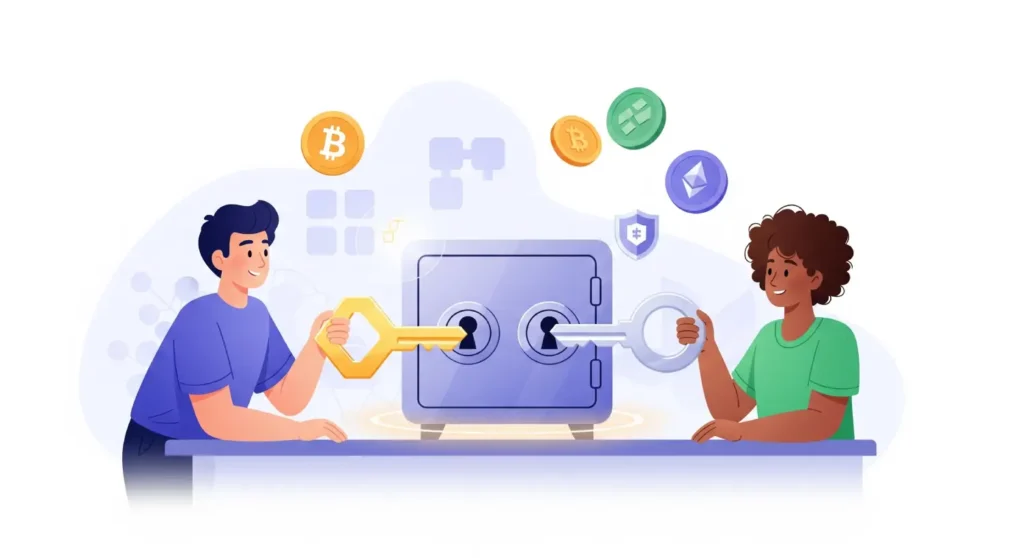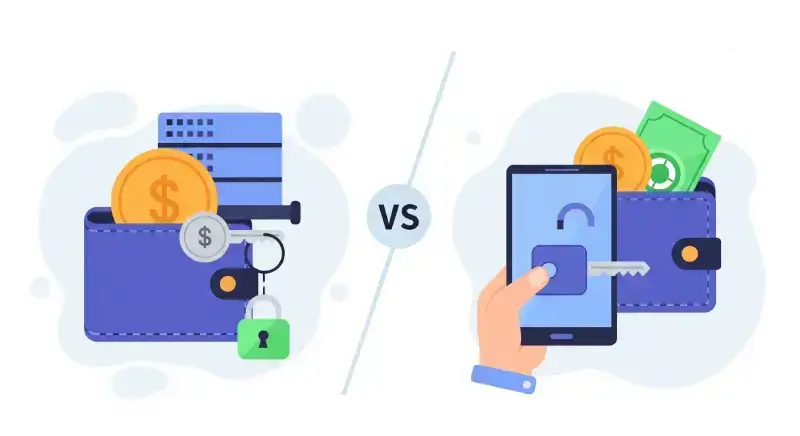
🔹 Why Multisig Wallets Matter?
Multisig wallets are a game-changer for cryptocurrency users. They require multiple keys to authorize transactions. This makes them far more secure than standard wallets.
Hackers target crypto daily. Losing a single key can lock your funds forever. Multisig, short for multisignature, solves this by spreading control across several keys, reducing the risk of theft.
This article explains multisig for beginners. You’ll learn what it is and how it works. Want to protect your crypto like a pro? Let’s explore multisig wallets step-by-step.
📌 Key Takeaways
- ✅ Multisig requires multiple signatures. Transactions need more than one key for approval.
- ✅ It enhances crypto security. Hackers must steal multiple keys to access funds.
- ✅ It’s ideal for shared control. Teams or families can manage assets together.
- ✅ Setup takes effort. Beginners may need time to understand the process.
- ✅ Key management is crucial. Losing keys can lock your funds permanently.
- ✅ Support varies by blockchain. Bitcoin and Ethereum work, but check others.
- ✅ Fees may be higher. Multisig transactions can cost more on some networks.
1. What Is Multisig?
A multisig wallet, or multisignature wallet, is a cryptocurrency wallet that requires multiple unique private keys to authorize a transaction. Unlike standard wallets that rely on a single key, multisig wallets distribute control among several keys, significantly enhancing security by reducing the risk of unauthorized access or theft.
Think of multisig like a bank vault with multiple locks. One key alone can’t open it; you need two or more keys to access the contents. Multisig was first introduced in Bitcoin to improve security. Today, many blockchains support it.
2. How Does Multisig Work? The Basics
Multisig wallets operate on a simple principle: multiple signatures are required to send funds.
A common setup is a 2-of-3 wallet, where three keys exist, but only two are needed to approve a transaction. This balances security and flexibility. For instance, you might keep one key on your device, give a second to a trusted friend, and store the third offline.
Another common scheme is 3-of-5, where three out of five keys must be used, offering greater flexibility and security for larger groups or complex use cases.
Each key in a multisig wallet is unique and has its own distinct seed phrase, ensuring that no single key can be replicated or replaced by another.
To send crypto, you propose a transaction, sign it with your key, and then get a second signature from another keyholder. Once both signatures are collected, the transaction is sent to the blockchain. Here’s the process in steps:
- 📝 Propose a transaction. You initiate a crypto transfer.
- 🔑 Sign with one key. This provides the first approval.
- 🤝 Collect another signature. A second keyholder signs off.
- 🌍 Submit to the blockchain. The transaction is finalized.
3. Benefits of Multisig Wallets
Multisig wallets are a powerful tool for crypto security. They offer unique advantages that make them appealing for many users. Here’s why they stand out:
- 🛡️ Stronger protection against theft. Hackers need multiple keys, not just one, to steal your funds.
- 🔄 Resilience to key loss in certain schemes: In setups like 2-of-3, losing one key doesn’t prevent access to funds, as long as other keys or their seed phrases are available.
- 🤝 Flexible for shared control. Businesses or groups can manage assets with multiple approvals.
- 🌐 Trustless collaboration. No single person has full control, reducing reliance on one individual.
For example, a company might use a 2-of-2 wallet, requiring both the CEO and CFO to approve transactions. This prevents unauthorized spending. Individuals can also use multisig to safeguard large crypto holdings from hacks or errors.
4. Drawbacks of Multisig Wallets
Multisig wallets aren’t without challenges. While they improve security, they come with trade-offs that users should understand. Here are the main drawbacks:
- 🛠️ Complex setup process. Configuring a multisig wallet can be intimidating for beginners.
- 💸 Higher transaction fees. Some blockchains charge more for multisig due to added complexity.
- 🤝 Dependence on keyholders. Unreliable partners could delay or block transactions.
For instance, setting up a 2-of-3 wallet requires creating and distributing multiple keys. If you choose an untrustworthy keyholder, they might refuse to sign transactions. Careful planning is essential to avoid these pitfalls.
5. Who Should Use Multisig? Use Cases
Multisig wallets are ideal for scenarios requiring enhanced security or shared control. Here are some common use cases:
- Businesses: Companies can use a 2-of-3 wallet to ensure that transactions require approval from multiple executives, such as a CEO and CFO, preventing unilateral spending.
- Investment Groups: A group of investors can use a 3-of-5 multisig wallet to manage a shared crypto portfolio, ensuring majority consensus for withdrawals.
- Family Trusts: Families can secure inherited crypto assets with a 2-of-3 scheme, where multiple family members must agree to access funds.
- Escrow Services: Multisig wallets can act as escrow, requiring approval from the buyer, seller, and a third-party mediator to finalize transactions.
These use cases highlight how multisig wallets provide flexibility and security for both individual and group needs.
6. How to Start Using a Multisig Wallet: A Step-by-Step Guide
Setting up a multisig wallet may seem complex, but it’s manageable with the right steps. Follow this guide to create a secure wallet and protect your cryptocurrency.
- ✅ Choose a compatible wallet.
Select a wallet that supports multisig for your blockchain. Some examples of key storage options include:- 🔒 Electrum. A reliable choice for Bitcoin multisig wallets.
- 🏠 Casa. User-friendly for beginners with guided setup.
- 🛡️ Safe. Perfect for Ethereum and NFT management.
- 💼 BitGo. Designed for businesses with robust features.
- ✅ Configure the wallet.
Decide on a scheme, such as 2-of-3, and generate the required keys. - ✅ Store keys securely.
Keep keys in separate, safe locations to minimize risks:- 🔐 Hardware wallet. Hardware wallets can support multisig setups when used with compatible external software that configures the multisignature requirements.
- 🤝 Trusted keyholder. Share some keys with a reliable family member or colleague.
- ✅ Test the wallet.
Send a small test transaction, such as $1 worth of cryptocurrency, to verify the wallet setup. Ensure multiple signatures are required to complete the transaction. - ✅ Create backups.
Securely save the seed phrases for all keys in separate, safe locations. Never store them digitally to avoid hacks.
This process requires effort, but it significantly enhances your crypto security.
7. Common Mistakes and How to Avoid Them
Multisig wallets are powerful, but errors can lead to problems. Avoid these common mistakes to keep your funds safe:
- 🔑 Losing all keys.
Without enough signatures, your crypto is inaccessible. Always create secure backups in multiple locations. - 🤝 Choosing unreliable keyholders.
A dishonest partner could block transactions. Select trusted individuals or use secure storage instead. - 🛠️ Improper wallet configuration.
A 2-of-2 scheme is risky if one key and its seed phrase are lost, as both are required to access funds. Opt for 2-of-3 or similar for flexibility. - 📅 Ignoring software updates.
Outdated wallets or blockchain changes can cause issues. Regularly check for updates to stay compatible.
8. Frequently Asked Questions
New to multisig wallets? Here are answers to frequently asked questions to clarify the basics:
Q1: How is multisig different from a regular wallet?
A: Multisig requires multiple keys to sign transactions, while regular wallets need only one. This adds a layer of crypto security.
Q2: Which wallets support multisig?
A: Options like Electrum, Casa, Safe, and BitGo support multisig. Always confirm compatibility with your blockchain.
Q3: Is multisig worth it for small crypto amounts?
A: It depends on your needs, but for small sums, a single-key wallet may suffice. Multisig is ideal for significant holdings.
Q4: What if I lose one key?
A: In a 2-of-3 setup, you can still access funds with the remaining keys. Ensure backups are secure to avoid total loss. If you lose a key but have its corresponding seed phrase, you can restore the key using the seed phrase on a compatible wallet.
Q5: Do multisig wallets have higher fees?
A: Some blockchains, like Bitcoin, charge more for multisig due to larger transaction data. Fees vary by network.
Q6: Can multisig work for Ethereum or NFTs?
A: Yes, wallets like Safe support Ethereum and NFTs. Verify your platform supports multisig for these assets.
Q7: How do I pick a multisig scheme?
A: A 2-of-3 scheme suits individuals for balance. Businesses may prefer 3-of-5 for added control.
🎯 Conclusion
Multisig wallets offer robust protection for your cryptocurrency. They guard against hacks, theft, and errors, making them ideal for serious investors or teams. However, they require careful setup and key management to work effectively.
For those holding significant crypto or managing shared funds, multisig is a smart choice. If you’re just starting with small amounts, a single-key wallet might be simpler. Either way, learning about multisig empowers you to secure your assets.
Explore More Crypto Security!
📘 Ready to dive deeper into securing your digital assets? 👉 Since you’re interested in advanced protection like multisig, you might also be interested in our guide Air-Gapped Protection for Beginners. It’s another powerful way to safeguard your crypto from online threats.

